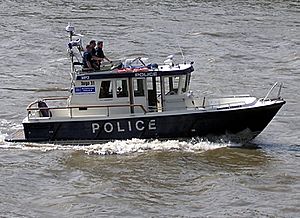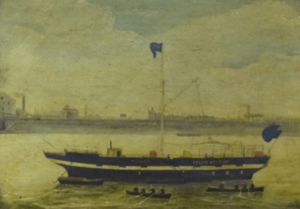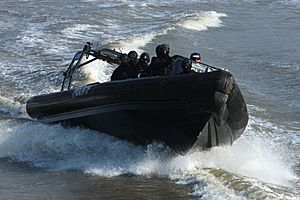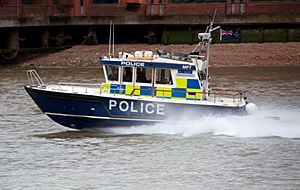Metropolitan Police Marine Policing Unit facts for kids
The Marine Policing Unit (MPU) is a special police team in London that works on the water. They are part of the Metropolitan Police Service, which is London's main police force. This unit has 22 boats that patrol the River Thames in Greater London. Their job is to keep the river safe and help other police teams with anything happening near London's waterways.
The MPU also has a special team that searches underwater and in small, tight spaces. They look for important items or evidence. Another group of 24 officers are trained to use ropes to climb tall structures. They can search high places or help during protests.
This unit started a long time ago, in 1839. It was first called the Marine Police Force and then the Thames Division. In 2001, it became the Marine Support Unit, and seven years later, it got its current name. The MPU is still based in Wapping, where the River Police Museum is also located. This museum was started in 1974 and shows the history of river policing.
Contents
Where the River Police Work
The Marine Policing Unit is in charge of a 47-mile stretch of the River Thames. This goes from Hampton Court in the west to Dartford Creek in the east. This area includes the part of the river that runs through the City of London, even though the City of London Police don't have their own river unit.
Further up the river, past Hampton Court, the Surrey Police take over. Downstream from Dartford Creek, the Essex Police and Kent Police work together. They have their own joint marine unit to patrol that part of the river.
History of the River Police
Early Days (1839-1945)
In 1839, the Marine Police Force joined the Metropolitan Police Service. They kept their main base in Wapping. For many years, officers patrolled the river in rowing boats. These small boats were used until 1905.
A big change happened on September 3, 1878. A steam-powered coal ship called the Bywell Castle crashed into a passenger boat named the Princess Alice. More than 600 people sadly lost their lives. After this accident, investigators said that the river police needed better boats. They recommended using steam launches because rowing boats were not good enough for police work. The first two steam launches were put into service in the mid-1880s. By 1910, the unit started using motor vessels.
For a long time, Wapping and some old navy ships (called "hulks") were the only bases for the river police. In 1874, they opened a new station at Waterloo Police Pier. Another station was built in Blackwall in 1893. This building had cells for prisoners, living areas, and a place to launch boats. The current Wapping station was built in 1907.
Modern Times (1945-Present)
After World War II, the Thames Division named some of its police boats after the people who helped start the unit. These included the John Harriott and the Patrick Colquhoun. Today, they still have boats named John Harriott and Gabriel Franks.
In the late 20th century, the docks in areas like Canary Wharf became less busy. Because of this, the Blackwall River Police Station closed in the 1970s. It was later turned into homes in 1982. In 1978, the Thames Division became a special unit with its own direct leader.
On August 20, 1989, a terrible accident called the Marchioness disaster happened. A large ship called the Bowbelle crashed into a passenger boat named the Marchioness near Cannon Street Railway Bridge. Four Metropolitan Police boats helped rescue 87 people. However, 51 passengers died. After this, the government asked several organizations to work together to create a dedicated search and rescue service for the River Thames.
As a result, on January 2, 2002, the Royal National Lifeboat Institution (RNLI) set up four lifeboat stations along the Thames. These stations are at Gravesend, Tower Pier, Chiswick, and Teddington. The RNLI now handles most of the search and rescue on the river, taking over from the Thames Division.
In August 2020, money was approved to replace six of the MPU's fast patrol boats. This included one larger command boat and five smaller, faster patrol boats. These new boats were delivered and started working between January 2022 and March 2023. The fast patrol vessels are all Targa 32 models, and the new command boat is a Targa 37.
| Vessel name | Police Code | Started Service |
|---|---|---|
| Sir Robert Peel III | MP9 | January 2022 |
| Gabriel Franks III | MP3 | Spring 2022 |
| Nina McKay III | MP4 | August 2022 |
| John Harriott V | MP7 | Summer 2022 |
| Peter Kruger (command vessel) | MP15 | November 2022 |
| Tim Ruprecht | MP2 | March 2023 |






